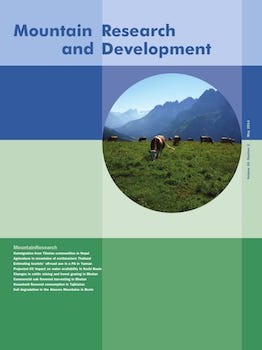Dear Readers,
In this Open Issue of MRD we are pleased to present research conducted from a number of disciplinary perspectives and focusing on matters of concern to people living both in the highlands and lowlands of different countries around the world. Most of the papers discuss the impacts that major internal and external cultural and economic changes are having on mountain areas. Mountains are also discussed as providers of resources: water, firewood, agriculture, and tourism are ecosystem services that are essential to all of us worldwide.
The first article combines anthropology and demographic studies—a rare combination of a qualitative and quantitative approach that delivers very interesting insights into a migration process which is likely to have quite a radical impact on ethnic Tibetans' relation to their traditional mountain environment in Nepal. G. Childs, S. Craig, C.M. Beall, and B. Basnyat analyze the impact of these communities' increasing tendency to send their children away for education, even to distant countries, and the resulting depopulation in the Nepalese valleys they inhabit. The next paper, by S. Choenkwan, J. Metz Fox, and A.T. Rambo, reviews the current state of agriculture in the understudied mountain ranges of Northeastern Thailand and draws some conclusions about development potentials in these mountains. This article is likely to become a reference for future scientific and development-oriented work on this distinctive agroecological zone.
In the next article, M. Yang, F. van Coillie, M. Liu, R. de Wulf, L. Hens, and X. Ou propose a geographic information system (GIS) approach to assess and predict how tourists move within a protected area in Northwest Yunnan. Due to technical limitations in mountains, new technologies such as smartphones can hardly be used to track tourists' movements, so the proposed method falls back on a model developed by Naismith, a 19th-century Scottish mountaineer, improving it with the help of new GIS insights. GIS and other modelling tools are also essential in the following article, in which L. Bharati, P. Gurung, P. Jayakody, V. Smakhtin, and U. Bhattarai model the impact of climate change on the availability of water in the Nepalese part of the large Koshi River basin. Using a selection of climate scenarios developed by the Intergovernmental Panel on Climate Change (IPCC) in 2007, the authors predict that the impacts are likely to depend on the altitude and location of sub-basins, with varying degrees of increase and decrease in precipitation, water yield, and flow volumes.
The next 2 papers discuss natural resource use in Bhutan: in their study of local communities' perceptions in two study areas in central and western Bhutan, K. Wangchuk, M. Wurzinger, A. Darabant, G. Gratzer, and W. Zollitsch describe how cattle raising is changing under the influence of a number of factors, and what impact this is having on forest grazing in these areas. The paper underlines the differences between the two areas and reveals one outstanding similarity—the preference for crossbred cattle, which may lead to a welcome reduction of forest grazing in future. M.R. Moktan presents a broad study of different communities' perceptions of the impact of commercial harvesting of oak for firewood on oak forests; he suggests that electricity should be promoted as a substitute for this dwindling resource. Firewood as a key resource in mountains is also the focus of the subsequent paper, by B. Mislimshoeva, R. Hable, C. Samimi, A. Abdulnazarov, M. Fezakov, and T. Koellner. Their study explores what factors are influencing firewood consumption today in the Western Pamirs, Tajikistan: more firewood was consumed the higher the elevation was, the smaller the household gardens were, and the higher the total number of heating hours was. By contrast, a higher education level and access to reliable electricity supply led to a decrease in firewood use.
The last paper in the MountainResearch section is by a team of Beninese and German soil specialists: F.A.Y. Okou, A.E. Assogbadjo, Y. Bachmann, and B. Sinsin. The authors explored a number of ecological factors that influence soil degradation in a rarely studied mountain range in Benin, West Africa, using a set of simple methods that can be applied without having to rely on elaborate expertise and laboratory facilities; the methods can thus be used by local people to assess the state of their own land.
In the MountainPlatform section, two new International Mountain Society members present their mountain-related activities: the Institute of Mountain Hazards and Environment (IMHE) in Chengdu, China, and the Department of Geography (DIG) of the Institute of Geography, University of Bern, Switzerland. The two institutions, which have very different backgrounds and mountain research traditions, increase the membership of the IMS to 11 members—a very positive sign of support in times where mountains seem to be less attractive on the global agenda.
We would like to conclude this Editorial by calling for more submissions presenting so-called “transformation” knowledge for the MountainDevelopment section ( http://www.mrd-journal.org/About_edpol.asp#dev), ie knowledge that is urgently needed for paving the way towards the Sustainable Development Goals that are currently being defined and will be of high relevance also to mountain people and mountain areas.





